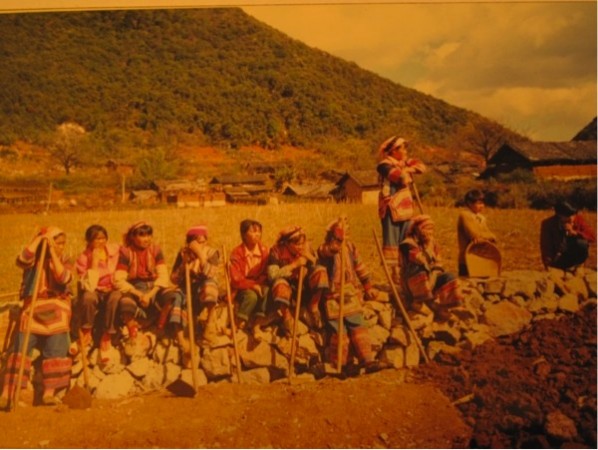
Women from Ashe, a rural area in southwestern China, rest after farming. (Photo by Jing Wang/El Nuevo Sol)
By JING WANG
EL NUEVO SOL
“I began to know sexual stuff when I was 25 years old. I’m ashamed of that,” said Yuan Zhou, a student of Yunnan University.
“I can’t give birth to a second baby because of one-child policy in China. I feel unhappy about that. The only thing I can do is to abort,” said Wei Liu, a professor of Yunnan Normal University.
Sexual Education
Yuan shared her first time experience of going to a class that teaches sexual knowledge. It’s her first time to systematically receive education about contraception, abortion and sexually transmitted diseases at her age. In China, there is a lot of young people ages 15-30 who share the same feeling with Yuan. This attracts the attention of the government. They already take this issue into account and realize the importance of sexual education.
However, teenagers do not have rights to receive official sexual education in their early age. Most of them have access to sexual information through television, films and internet instead of school or family education. Actually, schools and parents do very little to cultivate the young generation.
“Concerning the sexual instruction, I often feel so embarrassed to talk with my child and I have no idea how to educate her. Today, there are bunches of ways to get information, my girl is sometimes out of my control. I think that the school should take charge,” said Jianhuo Wang, a vice general manager in a Chinese company. His view represents the majority of parents’ in China. What’s more, some parents imagine that the earlier they children receive sexual education, the earlier they will have sex.This causes a terrible consequence—the high rate of abortion.
Wenbo Zhang, physician of obstetrics and gynecology department in the First Affiliated Hospital of Kunming Medical University, said that the number of abortion in his hospital is between 250-300 per month. Sixty percent of these young ladies are not married. Among these women, 30 percent had aborted more than once.
The pie chart illustrates that the number of induced abortion remains large; most cases are young and null parity women. Additionally, the frequency of abortion is high and sometimes the interval between the first and the second abortion is short. Furthermore, in some rural areas of China, people prefer boys. This is another reason which contributes to the high rates of abortion in China.
Healthcare
“I’m reluctant to do gynecological examination in a hospital when I feel bad. It’s not serious. I don’t need to worry. The crowd in hospital drives me crazy. I’m tired of waiting in a long line,” said Liu. Liu is just one of the women whose rights to receive high quality healthcare can’t be guaranteed. Thus, lack of health service for Chinese females is another challenge for the government. As well, there are several illegal clinics in rural areas in China. People also call them “black clinic,” which can’t help patients; on the contrary, sometimes they contribute to kill them.
When it comes to physical conditions of women, according to a China net survey, 90 percent of surveyed women are suffering from gynecological diseases. Eighty percent of women know nothing about the structure of female genital structure. Around 25 percent of women do not know the symptoms of cervicitis and more than 30 percent of women did not go through a health examination regularly. These statistics demonstrate that many Chinese women lack sexual education and self-protection awareness. It is hard for them to realize the sign of illness. As a result, they miss the best period for treatment.

Children from Ashe, a rural area in southwestern China, wait for their working mothers. (Photo by Jing Wang/El Nuevo Sol)
“One Child Policy”
The implement of “One Child Policy” in 1983, aimed to control the population, reduce the consumption of resources, and advance the growth of Chinese economy. Nevertheless, advantages are often followed by drawbacks. On the one hand, women are unable to exercise their rights. They can’t decide the number of their children and many women had to stop their pregnancies in order to support this compelling policy. On the other hand, no child wants to grow up alone. Loneliness often leads to mental disease. Parents often spoil their child and give their child whatever they want. Thus, children often lack responsibility, ability to adapt, sense of gratitude, and so forth. The burden on future generation gets more and more heavy. With the increase of an aging population, one child should support four elders.

Obstetrics and gynecology department of the First Affiliated Hospital of Kunming Medical University (Photo by Wenbo Zhang)
As it is said in Joan C. Chrisler’s book “Reproductive justice: A Global Concern”: “Reproductive justice” is a relatively new term that gives emphasis to the fact that the existence of reproductive rights does not mean that women are able to exercise those rights. In China, young women can’t exercise their rights to receive formal sexual education, which causes the high rates of abortion. Besides, there isn’t enough health service for females. And last, because of limitation of “One Child Policy,” women can’t decide the number of babies they want to have. In some rural areas, women are unable to exercise their rights for several reasons, such as lack of money or health insurance to pay for services, lack of accessible services in their region, and the preference of boys in their family. How to fix these problems? What action should be taken in order to guarantee that women exercise their reproductive rights?
Related articles:
Low-income families develop healthier food habits
Korean abused women: Survivors of language barrier, isolation, and lack of public services
Tags: China FIrst Affiliated Hospital of Kunming Medical University health care Jing Wang one child policy reproductive justice sexual education women's rights Yunnan University















